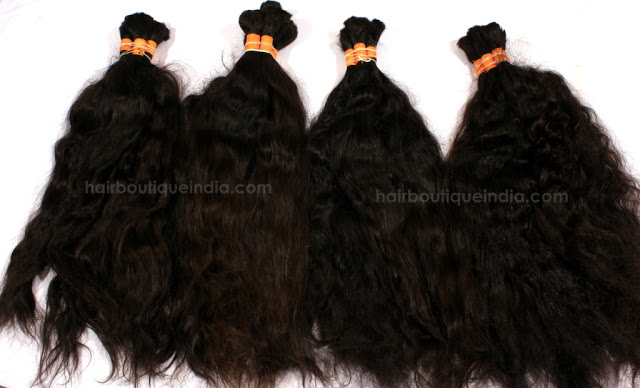
But very few women who wear hair extensions have given more than a fleeting thought to where they come from — or, more alarmingly, from whom.
Here, we trace the astonishing, and at times disturbing, journey of a set of extensions from their donor — a destitute young woman in the slums of India — to the well‑heeled clientele of a British hairdresser . . . and reveal the truth about the multi-million-pound hair trade.
THE SHAVEN HEAD OF A ‘VIRGIN’ DONOR IN INDIA
At Yadagirigutta Temple in southern India, poor women wait patiently in line for their heads to be shaved.
According to the documentary “Hair India,” Hindu pilgrims have donated their hair at holy temples throughout Southern India for centuries in an attempt to purify themselves and repay debt to their gods.
As legend has it, Vishnu — an avatar of God and the Preserver of the World — took out a loan in order to pay for his wedding. But Vishnu’s loan was so large that it would take him thousands of years to pay off his debt. Now many devout Hindus help pay off Vishnu’s debt by offering the only thing they have: their hair.
Most have never coloured, blow-dried or even cut their locks, and this so-called ‘virgin hair’ is particularly prized by the barbers, who will take just five minutes to cut it off with steel blades.
Among them is Lavanya Kakala, a dignified 28-year-old in a deep pink sari who has just had her waist-length hair shorn. She will receive nothing in return — and insists she wants nothing.
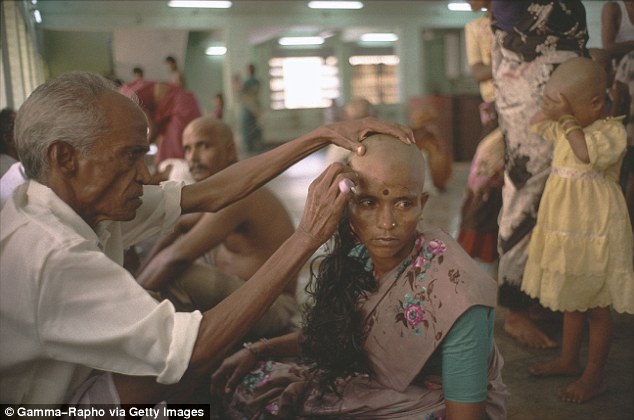
‘I did this because I wanted to say thank you to my God. I’m not bothered what happens to my hair afterwards. If women with bad hair want to use my old hair to look better, it’s better than it going in the bin.’
It is traditional for women to donate their hair to Hindu temples, knowing it will be sold on to dealers to raise funds.
At times 50,000 a day stand in queues up to two miles long to participate in ‘tonsuring’ ceremonies. It is considered an act of pilgrimage, in which their heads are shaved and then coated in antiseptic sandalwood paste.
Lavanya’s hair is of the highest quality. Indian women, particularly in the south, avoid chemical shampoos, comb their hair frequently and douse it in coconut oil to keep it silky.
Though dark in colour, the strands take well to bleaching, so they can end up blonde, which is the most popular colour in British salons. As a result, Indian hair is in demand and the country is one of the top exporters.
Tonsuring has provoked much controversy in the West, not least because many pilgrims are children, some no older than five or six.
Known most commonly as “temple hair,” these real human-hair extensions are available in many salons in Europe and the U.S., where they cost about $5,000 each time they are put in. Despite the high price, many have opted to use these extensions since real extensions look and feel better than synthetic hair.
Though most extensions made from actual human hair comes from China, Indian hair is more valuable since it is “naturally silkier and has never been treated with artificial dyes.” In many cases, the hair has never been subjected to anything more abrasive than coconut oil and herbal soap, and has sometimes never been cut before.
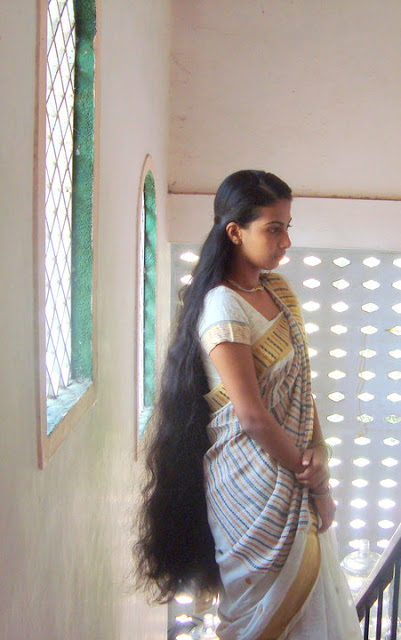
But what’s particularly upsetting to many is that the temples reap millions of dollars in profit from the pilgrims religious sacrifice, while the donors, many of whom are poor, never see so much as one cent for their hair.
Rich vs poor
Temple officials have defended their decision to sell the hair, arguing that the hair would otherwise be thrown away, but the money the temple earns from the hair sales can be used to fund orphanages and hospitals.
“For example, we financed children’s education by building schools. We distributed approximately 30,000 free meals every day for the poor and needy, and we have built hospitals to cure those who, otherwise, could never afford such expensive treatments,” said a director at the Tirumala Temple.
While the director may have a point, it doesn’t explain why poor women are shaving their heads more often than wealthier women, who donate three strands instead.
“For poor rural women, their hair is their only vanity,” said Mayoor Balsara, chief executive of India’s largest exporter of human hair, Sona Devi Trading Company. “They have saved up to make a once-in-a-lifetime journey. Thousands have made an oath to their gods – they may have asked to be blessed with a child or for a good harvest. Should their wish be fulfilled, they offer their most precious possession as a sign of gratitude.”
Punari Aruna, 40, donated her hair after ending her 30-hour pilgrimage to the temple. Accompanied by 25 of her relatives, Aruna said this was her fifth time donating her hair, because
“Offering your hair to the god is a symbolic gesture of surrendering one’s ego and a way of giving thanks for your blessings.’”
But some people who have learned of this hair trade have begun to exploit impoverished and devout Hindus outside of the temples, by collecting hair from people’s personal hairbrushes and convincing men to force their wives to shave their heads for $10.
Tirumala Venkateswara, for example, attracts tens of thousands of pilgrims each day, making it the temple with the most hair donations in India. The temple features 18 shaving halls, but there are so many people waiting to donate their hair that women and young girls can wait for up to five hours to donate.
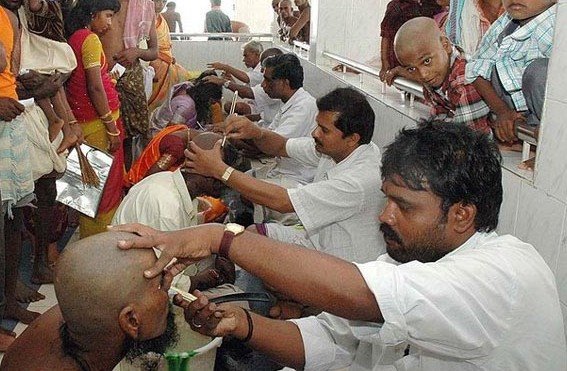
At the temple, some 650 barbers sit in lines on the concrete floor and tie the women’s hair into ponytails before cutting it off. Once the large portions of hair are removed, the barbers use a razor to shave each pilgrims head, before dousing their head with water to wash away any blood.
SHADY DEALERS WHO TARGET THE POOR
The temples are far from the only players in this international trade.
More contentious is the rise of hair dealers, who travel around Asia and Eastern Europe offering destitute young women a pittance for their locks.
In India, they’ve been known to target men, offering them £6 if they persuade their wives to sell their hair.
There have been reports of husbands forcing their wives to do so, and of women being attacked and shaven by gangs.
Slum children have been tricked into having their heads shorn in exchange for toys.
‘I was held down by a gang of men who hacked at my hair,’ one girl said. ‘I know of other women who have been blackmailed and threatened.’
HUNTING FOR HAIR ON RUBBISH HEAPS
The average woman loses between 50 and 100 hairs a day — and this isn’t something traders want to waste.
Pedlars across Asia, Eastern Europe and South America visit houses and hair salons to collect this ‘dead’ hair.
It is often in poor condition and donors receive only a couple of pence, or an item such as a hair clip or bar of soap.
Other hair is swept from doorsteps at night or raked from rubbish dumps, where families hunt for strands pulled from hair brushes.
Pedlars, of whom there are thought to be 500,000 in Asia alone, deposit the hair in warehouses, where it is sold to the firms who deal in shorter, lower-quality strands.
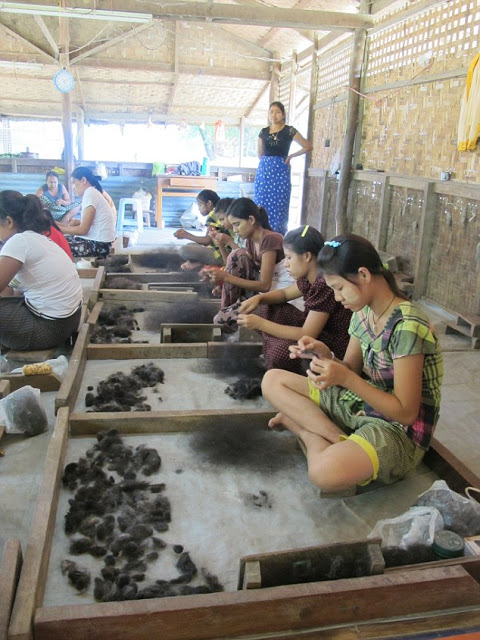
This hair is known as ‘comb waste’, and is harder to sort and clean. The resulting extensions are sold for as little as £5.
SECRET STASHES OF ‘BLACK GOLD’
Once hair is collected, it’s transported (rolled up in huge bales like hay) by road and plane to factories, and distributed to workers — as many as 350 per site — to be processed.
There’s a lot of secrecy in the trade. Obtaining hair is not easy, and there’s a risk of it being stolen while in transit. ‘Hair collectors are in competition,’ says Ms Tarlo.
‘The factories don’t want to reveal their sources and they don’t want to give away their methods for bleaching or processing the hair
‘Hair is worth a lot of money — it’s known in the industry as “black gold”.’
PAINSTAKINGLY DETANGLED BY HAND
The first stage is untangling: a mammoth job that is completed by hand.
It’s a thankless task, painfully slow, puts a terrible strain on the eyes and back — and is very badly paid.
It takes one person a day to untangle just 150g of hair.
One female worker in a Chinese factory was 83 years old, working through a knot of hair with a darning needle.
‘I can’t see much, but I make up for it with patience,’ she said.
Next, the hair is hackled — repeatedly pulled through a comb with sharp iron prongs to smooth it into uniform locks.
The third stage is known as drawing out, or sorting the strands into different lengths, before it’s combed and tied into bunches.
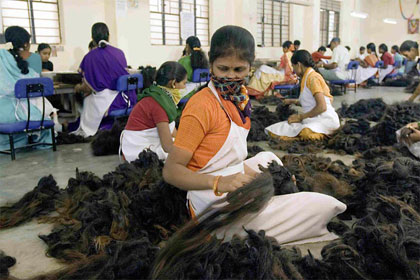
By the end they look like the finely groomed tails of dressage competition horses.
SOAKED IN CHEMICALS TO MAKE IT BLONDE
The next part is soaking the hair. The cheaper comb waste is soaked in acid to remove germs.
High- quality hair is placed in an osmosis bath, the exact composition of which is a closely guarded secret.
A mixture of chemicals slowly removes dark pigments without damaging the cuticles (the outer part of the hair shaft), which would otherwise leave it dry and brittle.
The gentle process enables hair to keep its shine and elasticity, but leaves it colourless and ready for dye.
In the case of platinum blonde, it’s kept in the bath for 20 days to ensure the right result; brown or auburn extensions need ten days.
Before immersing the hair, the workers sew each strand to white strips of fabric. This gives a smooth, straight finish.
If the hair is to be curled (some extensions come with built-in waves), it’s dried, wrapped around sticks and baked in a huge oven at a temperature of 240c to set the curl.
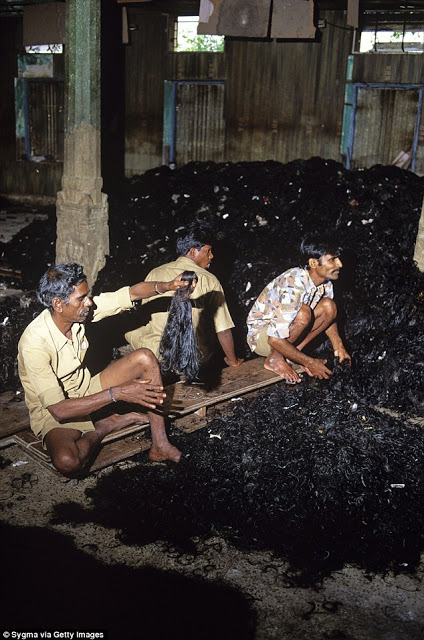
BULKED OUT WITH GOAT OR HORSE HAIR
At the lower end of the market, what’s labelled hair isn’t always what it seems.
Human hair might have been mixed with animal hair such as strands of horses’ manes or clippings from goat hides or artificially weighed down (it’s sold by weight) with dirt, oil or water.
Synthetic hair can also be found in ‘real’ extensions.
Made from acrylic fibres, it’s coarser than human hair and doesn’t hold a style when heated, so it can’t be blow-dried or curled.
On average, each woman donates about 10 oz of hair, which goes for about $350. Baskets filled with hair are collected every six hours and stored in a vast warehouse where it is piled knee deep.
It’s estimated that each year India exports an estimated 2,000 tons of temple hair a year. The best – or longest – hair will sell for about $580 per pound. The hair is sold in yearly auctions that take place in March or April.
According to Balsara, one ton of hair is equal to donations from about 3,000 women. Since the shaving ceremony and sale of hair is not limited to one holy site, and 85 percent of the people in India are Hindu, those companies that export India’s human hair don’t foresee a shortage of temple hair anytime soon.
All of the hair goes to the highest bidder — it’s that simple. And if it’s not purchased by a hair extension or wig manufacturer, Indian hair is used to stuff mattresses, create oil filters or extracted for the amino acids.
Once it’s smooth, the hair is packed into cardboard boxes and shipped to Nepi, Italy, where the pigment is removed by soaking the hair in a solution for up to 20 days.
The company sells its hair extensions to salons all over the world, including in India, which some say is rather ironic, as India’s poorest donate their hair to the gods, the only item of value they have, so those in India’s high society can have long, luscious locks.
Watch the video below!


![Aisha Buhari Presented an Award by Belgium Deputy Prime Minister [PHOTOS] 8 Aisha Buhari Presented an Award by Belgium Deputy Prime Minister [PHOTOS] 8](https://www.kanyidaily.com/wp-content/uploads/2016/10/Aisha-Award-1-150x150.jpg)
![Obafemi Martins Buys 2017 Bentley Bentayga Worth Over N100million [PHOTOS] 9 Obafemi Martins](https://www.kanyidaily.com/wp-content/uploads/2016/10/Obafemi-Martins-150x150.jpg)
![American Rapper, Gunna Arrives In Nigeria For Lagos Concert [Video] 11 American Rapper, Gunna Arrives In Nigeria For Lagos Concert [Video]](https://media.kanyidaily.com/2024/12/21164103/Gunna-150x150.jpg)
![Williams Uchemba Gifts Wife A Rolex Watch After Welcoming Their Second Child [Video] 13 Williams Uchemba Gifts Wife A Rolex Watch After Welcoming Their Second Child [Video]](https://media.kanyidaily.com/2024/12/21160810/Williams-Uchemba-wife-150x150.webp)


![Over 20 People Killed In Stampede At Rice Distribution Event In Okija, Anambra [Video] 19 Over 20 People Killed In Stampede At Rice Distribution Event In Okija, Anambra [Video]](https://media.kanyidaily.com/2024/12/21131654/Anambra-stampede-150x150.jpg)




![Jarvis Vows To Return Peller's Engagement Ring Over His Relationship With UK Lady [Video] 29 Jarvis Vows To Return Peller's Engagement Ring Over His Relationship With UK Lady [Video]](https://media.kanyidaily.com/2024/12/21094158/Peller-Jarvis-150x150.jpg)

